A legacy both religious and cultural
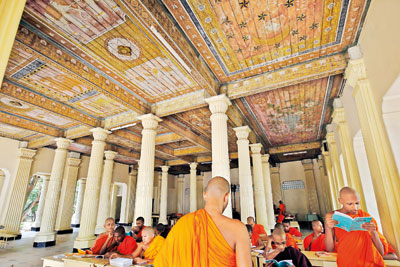
Samaneras at their books in the Dharma Shalawa with paintings by M. Sarlis on the wooden roof. Pix by M.A. Pushpa Kumara
Fame it has achieved as a seat of learning nearly 150 years ago, spreading the gentle and all encompassing message of metta (loving kindness), karuna (compassion), mudita (sympathetic joy) and upekkha (equanimity) of Lord Buddha.
Even now, about 250 samaneras, small and big, in their saffron-robes gather after regular school for lessons on the dhamma at the Vidyodaya Pirivena in Maligakanda amidst the hustle and bustle of Maradana.
While millions of Buddhists clad in white will throng temples bearing trays of lotuses or light little clay lamps and joss-sticks on the thrice-blessed day of Vesak to pay homage to the Buddha or string up colourful kudus from the eaves of their homes, within the serenity of the Vidyodaya Pirivena lies enfolded a most revered relic.
The largest fragment believed to be from Lord Buddha‚Äôs ‚Äėdane welandu paatraya‚Äô or his very begging bowl is enshrined in the pirivena‚Äôs ‚ÄėDathu Mandiraya‚Äô (Relic Chamber).
It is not only this relic, an exposition of which is held every six years, that should beckon the devout Buddhists to gather in their numbers but also the full legacy, both religious and cultural, of the Vidyodaya Pirivena now under the guidance of Chief Priest Balangoda Sobitha Na Himi.
For, this was the hub from which the Buddhist revivalist movement blossomed in the 19th century under the inspirational guidance of the erudite Hikkaduwe Sri Sumangala Thera (1827-1911) who was also a fiery orator. His name is inextricably linked to the famous Panadurawadaya, the religious debate between Buddhist monks and Christian missionaries in Panadura in 1873 while then Ceylon was under the yoke of the colonizers. Not only was he founder of the Vidyodaya Pirivena, when missionaries were establishing schools across the country, he was also appointed Chief Priest of the holy mountain of Sri Pada in 1864.
‚ÄúThe Bowl Relic was the largest of 13 fragments excavated in the late 1800s from Sopara near Mumbai, India,‚ÄĚ says the pirivena‚Äôs spokesperson Gayan Chanuka Vidanapathirana, adding that as eminent Hikkaduwe Sri Sumangala Thera was not only well-known for his scholarship but also much respected, this relic was presented to him as also numerous others. And it is not just Buddhist relics that have been gifted to him, for preserved in the museum of the Dathu Mandiraya just beyond the Bowl Relic is a tome-like Bible along with its case.
The beautiful Bible had been a gift by none other than Edward VII, ‚ÄėKing of the United Kingdom and Emperor of India‚Äô from January 22, 1901 to 1910.
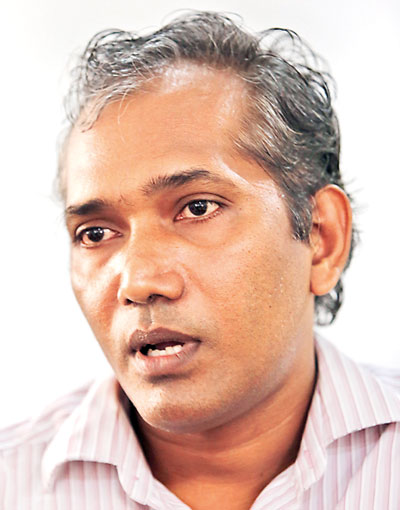
Gayan Vidanapathirana
On Tuesday, shoe-wear cast off, unperturbed by the noon-day heat in the green and still haven that is the Vidyodaya Pirivena with only muted sounds of the city indicating that this is Colombo, we go back in time, more than 2,500 years, to be enriched once again by the life of one of the greatest philosophers of this world who pointed people in the direction of the Middle Path.
The most prized possession — the Bowl Relic — lies within three caskets (karandu) ‚Äď the inner-most of crystal, then silver and outer-most of wood in the Dathu Mandiraya accessed by two wooden staircases, the ground floor of which had been the Spartan avasaya (abode) of Hikkaduwe Sri Sumangala Thera.
The most number of Buddhist relics, coming in second only to the hallowed Ruwanveliseya in Anuradhapura, is enshrined in the Maha Stupa or Chaithya of the Vidyodaya Pirivena, says Gayan, adding, ‚ÄúGanan karanna beri pramanayak nidan karala thiyena‚ÄĚ.
The pinnacle placed in 1906 is unique, according to him, for there was no protective lightning conductor nor were chuda manikya enshrined but a swarnalepa Buddha prathimavak in a cone-shape.
All these had been donated to the Vidyodaya Pirivena due to the fame of Hikkaduwe Sri Sumangala Thera both locally and internationally and is attributed by Gayan to his ‚Äúsilvath kama, gunawath kama and ugath kama‚ÄĚ.
While Hikkaduwe Sri Sumangala Thera had read the Tripitaka (the sacred scriptures of Buddhism) 36 times, he had also mastered nine languages including English and was thus able to exchange views and engage in debates with the colonizers. Many including members of the royal families of Thailand, Cambodia and Burma had arrived in delegation to pay homage to him, while numerous Buddhist relics had been gifted to him from India and Pakistan.
Among the treasured sepia-toned photographs preserved in the museum are those documenting a visit by Mahatma Gandhi to the Vidyodaya Pirivena and the letter authorizing Sir Henry Steele Olcott to promote the Sasana and establish Buddhist schools such as Ananda College, a stone’s throw from the Vidyodaya Pirivena, with the first signatory being Hikkaduwe Sri Sumangala Thera.
It was also this scholar-monk from among a handful who paved the way for greats such as Anagarika Dharmapala and Bramacharya Walisinghe Harischandra to take up the quest of spreading the teachings of Lord Buddha far and wide and reviving Buddhism.
As we linger awhile under the rustling leaves of the bodhiya, all pointers are that the bodhiya too is old, easily spanning a hundred years, with the bo-maluwa taking the unique shape of a crown.
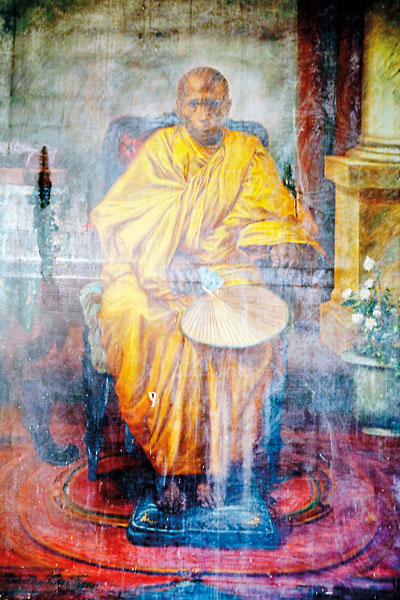
Hikkaduwe Sri Sumangala Thera: Painting by Richard Henriques
Ensconced between the bodhiya and the Dathu Mandiraya earlier known as the ‚ÄėPoth Ge‚Äô is the Sri Sumangala Dharma Shalawa with direct access through a sky-walk to the Dathu Mandiraya. While the samaneras in little groups take up their books in the Dharma Shalawa, an upward glance at the wooden roof brings into focus beautiful paintings in the Kandyan style.
The masterpiece here is the Dharmasanaya (the seat from which the monk preaches bana), intricately carved of ebony and donated to the Vidyodaya Pirivena back in 1930.
Meanwhile, the museum portraying a large painting of Hikkaduwe Sri Sumangala Thera by Richard Henriques in 1899, is home to the basic knick-knacks used by this monk in his frugal life such as brass pots, a bronze water kettle, a wooden plate, a pair of spectacles and walking staff, a plump ink-pen and much more including panhinda (writing stylo) used for ola leaves and also ola booklets and moth-eaten, yellowed and frayed letters, testimony to the monk’s sphere of influence.
In the premises of the Vidyodaya Pirivena, within a small commemorative tomb taking the shape of a stupa, lie the ashes of Hikkaduwe Sri Sumangala Thera.
As we depart, the thought uppermost on our minds is ‚Äúwhy, oh why‚ÄĚ do we need to venture on pilgrimages far out of Colombo, when right in the city‚Äôs heart at Maligakanda, on our door-step, lies the ‚Äėeye‚Äô of the cyclone of life that is the Vidyodaya Pirivena. Here we can meditate, listen to bana, observe sil and re-integrate enriched and re-invigorated, into the rat-race of modern-day living.
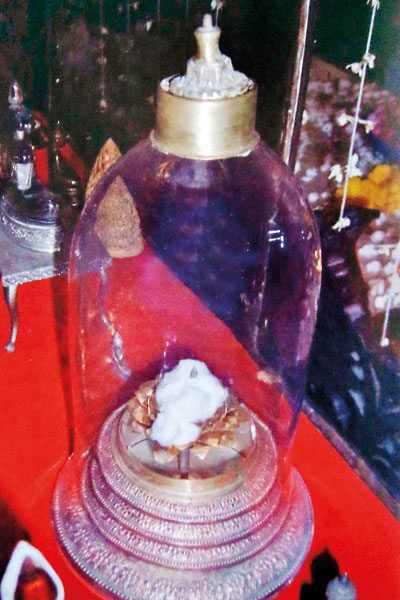
The fragment of the Bowl Relic of Lord Buddha
| The Budu Ge, a work of art The Budu Ge with the reclining, standing and Samadhi Buddha statues is the sparkling gem in the crown of the Vidyodaya Pirivena. Old murals on the walls and the roof depicting the Jathaka stories, encapsulate through brush and paint, the life of Lord Buddha, from birth to enlightenment to attainment of nirvana, while sculptures of lions, makara thorang and leaders enhance the scenes. The artwork is by well-known Buddhist revivalist painter M. Sarlis. Even the panels of the wooden door leading to the inner sanctum exhibit colourful paintings as well as a wonder of yore ‚Äď the art of fixing iron-hinges which link the doors to the stone (kalu-gal) arch. 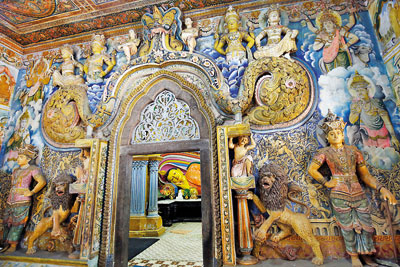 The ornate art of the Budu Ge |


